The living room serves as the heart of the home-a multifunctional space designed for relaxation, socialising, and personal expression. As design trends evolve, the definition of contemporary living rooms is broadening, moving beyond stark minimalism to embrace a more personalised, comfortable, and functional aesthetic. Today's contemporary style is no longer confined to strict rules of clean lines and neutral palettes; instead, it represents a rich tapestry of texture, integrated technology, and natural elements, all curated to create a space that feels both current and timelessly inviting.
This guide delves into ten of the most influential and achievable design ideas shaping modern living spaces right now. We will provide actionable insights and practical tips to help you transform your own living area into a sanctuary of sophisticated style. From mastering the seamless flow of open-concept layouts and the organic elegance of curved furniture to the impactful statement of bold accent walls, you'll find everything you need to create your ideal environment. Prepare to be inspired as we break down the key elements that define truly exceptional contemporary living rooms, offering a blueprint for modern comfort you can implement in your own home.
1. Open-Concept Living Spaces
The open-concept layout is a cornerstone of contemporary living rooms, championing a seamless flow between living, dining, and kitchen areas by removing interior walls. This architectural choice dramatically enhances the sense of space and light, creating a bright, airy environment perfect for both social gatherings and everyday family life. Popularised by pioneers like Frank Lloyd Wright and brought into modern homes by figures such as Joanna Gaines, this design promotes connectivity and multifunctional living.
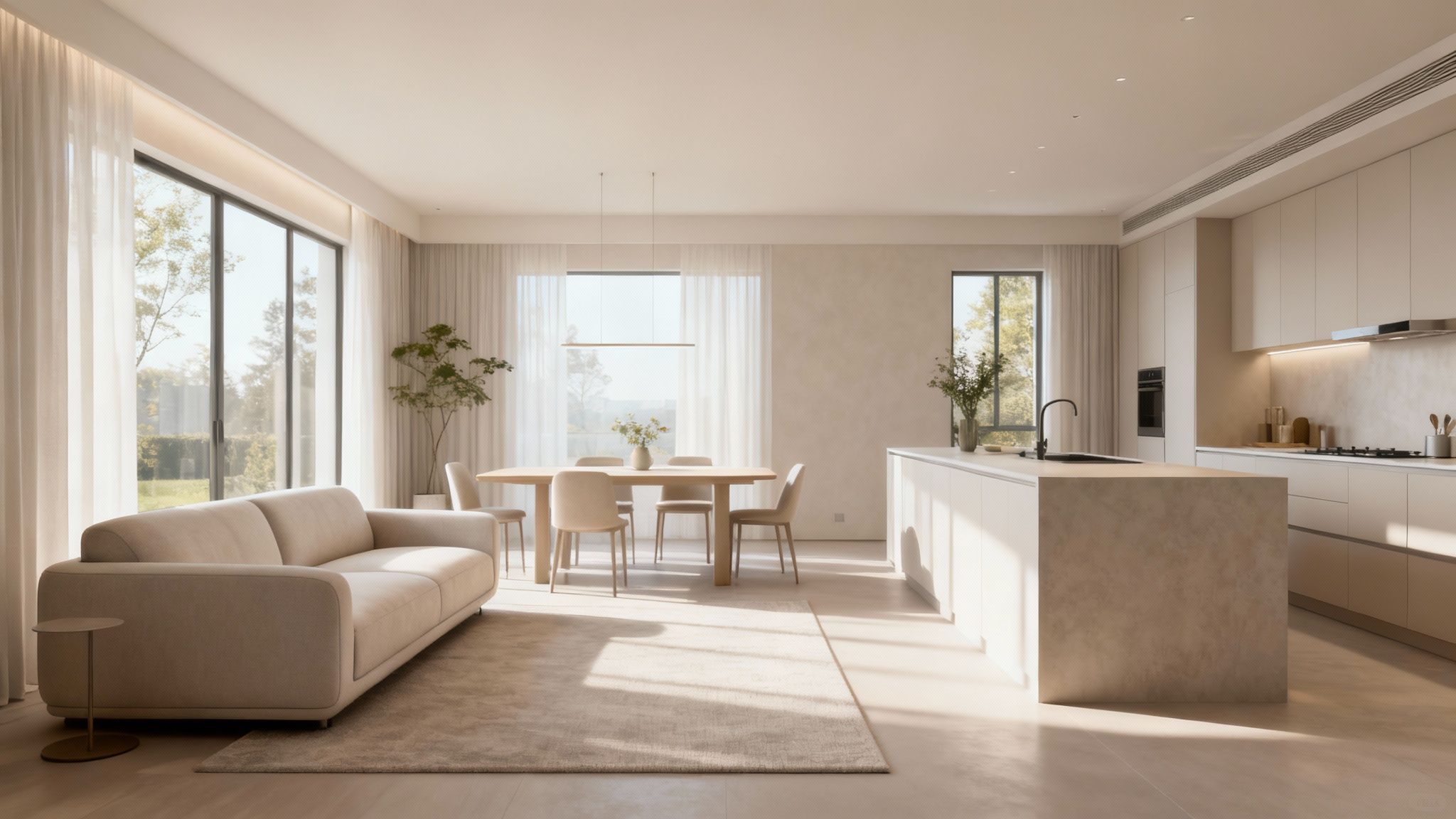
Defining Zones Without Walls
While the absence of walls is freeing, creating distinct functional zones is key to avoiding a chaotic, undefined space.
- Area Rugs: Use large area rugs to anchor furniture groupings and visually separate the living area from the dining space or kitchen.
- Furniture Placement: Arrange furniture, like placing a sofa with its back to the dining area, to create a subtle psychological barrier. A well-placed console table behind the sofa can further solidify this division.
- Consistent Palette: Unify the entire open-plan area with a cohesive colour scheme. Introduce accent colours specific to each zone for a layered yet harmonious look.
Practical Considerations
To ensure an open-concept living room remains functional and comfortable, address practical challenges such as acoustics and odours. Installing a powerful, yet quiet, extractor hood in the kitchen is essential for managing cooking smells. For acoustics, incorporate soft furnishings like thick curtains, plush rugs, and upholstered furniture to absorb sound and reduce echo, making the large space feel more intimate and serene.
2. Minimalist Aesthetic
The minimalist aesthetic is a cornerstone of many contemporary living rooms, embodying the philosophy that 'less is more'. This design approach prioritises functionality and simplicity, creating an uncluttered and serene environment through clean lines, a muted colour palette, and highly curated furnishings. Popularised by figures like tidying expert Marie Kondo and architect John Pawson, minimalism strips away the non-essential to foster a sense of calm and intentionality in the home.
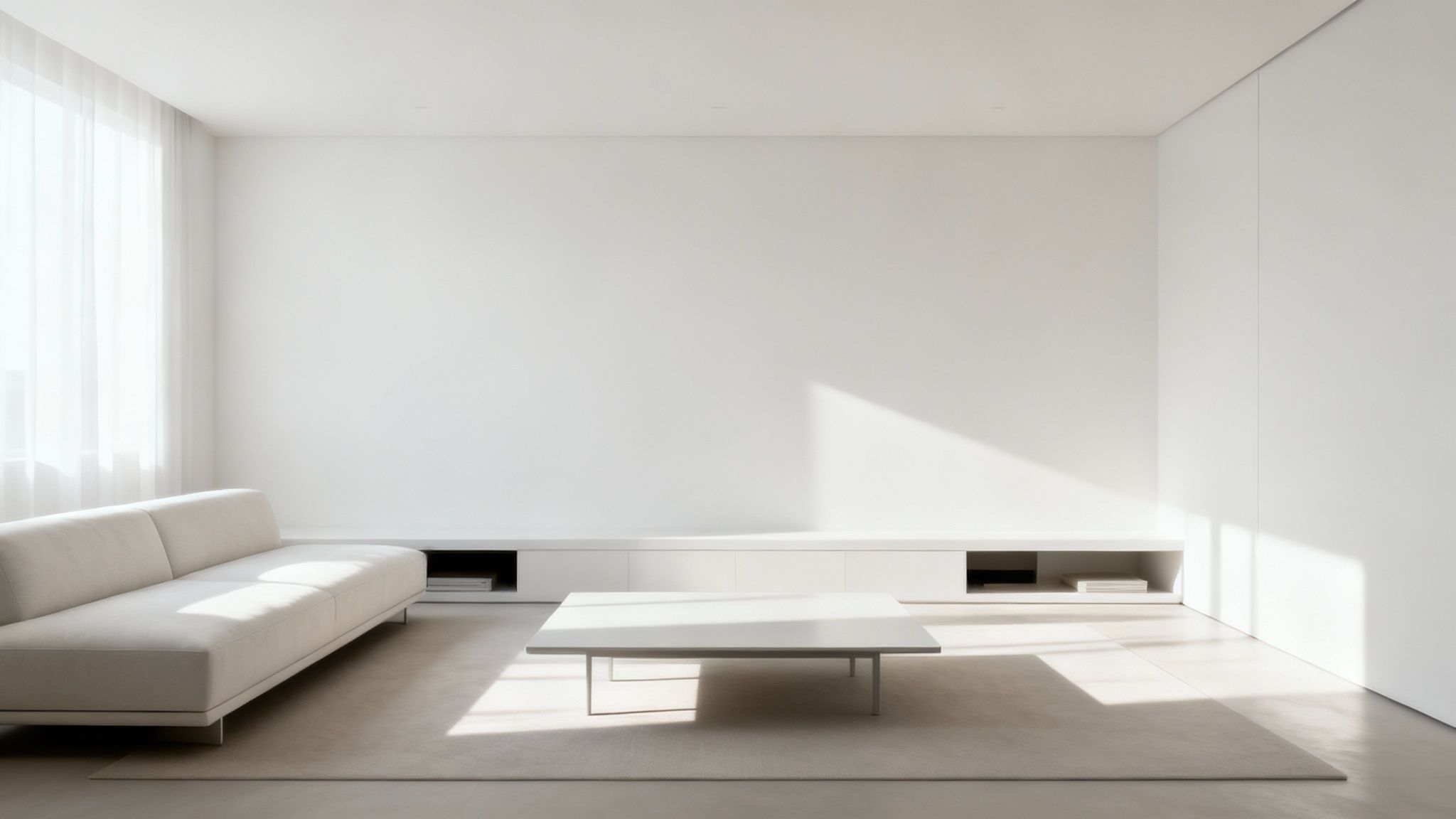
Creating Warmth Without Clutter
A common misconception is that minimalist spaces are cold or sterile. The key is to introduce warmth and character through deliberate, thoughtful choices that don't add to visual noise.
- Vary Textures: Introduce different textures to add depth. Combine a smooth leather sofa with a chunky knit throw, a soft wool rug, and linen curtains to create a rich, tactile experience.
- Embrace Natural Materials: Use natural elements like light-toned wood, stone, and rattan. These materials bring an organic, grounding quality to the space, preventing it from feeling stark.
- Statement Lighting: Choose a sculptural floor lamp or a unique pendant light. This serves as a piece of functional art, adding a focal point without cluttering surfaces.
Practical Minimalism in Action
Maintaining a minimalist living room requires a disciplined approach to organisation and consumption. Invest in multi-functional furniture, such as a coffee table with hidden drawers or an ottoman with storage inside, to keep everyday items out of sight. Adopting a 'one in, one out' rule for new purchases helps prevent accumulation. By focusing on quality over quantity and ensuring every item has a purpose and a place, you can create a truly restful and sophisticated contemporary living room.
3. Biophilic Design Integration
Biophilic design is a core principle in many contemporary living rooms, focusing on connecting occupants with the natural world. This approach involves the strategic use of plants, natural materials like wood and stone, organic shapes, and nature-inspired elements to create a calming, restorative environment. Popularised by experts like Oliver Heath and researchers such as Stephen Kellert, this philosophy recognises our innate need for nature, resulting in spaces that can reduce stress and improve wellbeing.
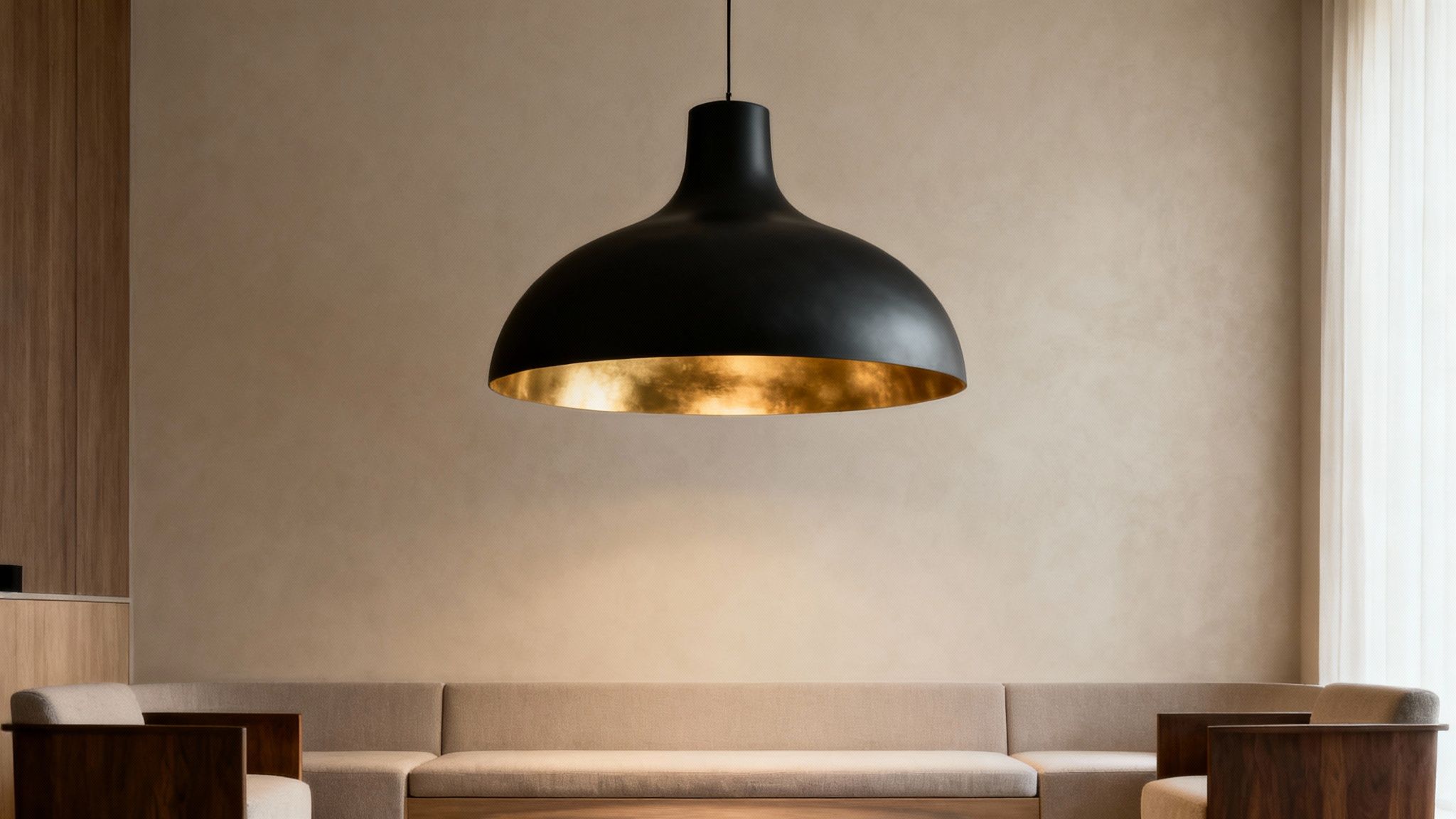
Weaving Nature into Your Space
Integrating biophilic elements goes beyond simply adding a houseplant; it’s about creating a cohesive, nature-infused atmosphere. For an in-depth exploration, you can learn more about what biophilic design is.
- Layered Greenery: Start with low-maintenance plants like snake plants or pothos. Group them at different heights using stands and hanging planters to create lush, visual layers that mimic a natural landscape.
- Natural Materials: Choose furniture made from natural wood with a visible grain, or incorporate stone, rattan, and jute accents. These textures add warmth and a tangible connection to the outdoors.
- Organic Forms: Select furniture and decor with soft, curved lines and flowing shapes rather than harsh, geometric angles. This reflects the organic forms found in nature, promoting a more relaxed feel.
Maximising Natural Elements
To fully embrace biophilic design, consider the less obvious natural elements like light and air. Position seating to maximise views of the outdoors and use sheer curtains to allow natural light to flood the room. Good ventilation and even the sound of a small indoor water feature can enhance the multi-sensory connection to nature, making your contemporary living room a true sanctuary.
4. Statement Lighting as a Focal Point
In contemporary living rooms, lighting transcends its purely functional role to become a central, sculptural element of the design. A dramatic light fixture acts as the room's jewellery, establishing a focal point that captures attention and sets the tone. Designers like Tom Dixon and manufacturers such as Flos have popularised this approach, where oversized pendants or artistic chandeliers are used to inject personality and make a bold style statement, transforming the entire feel of the space.
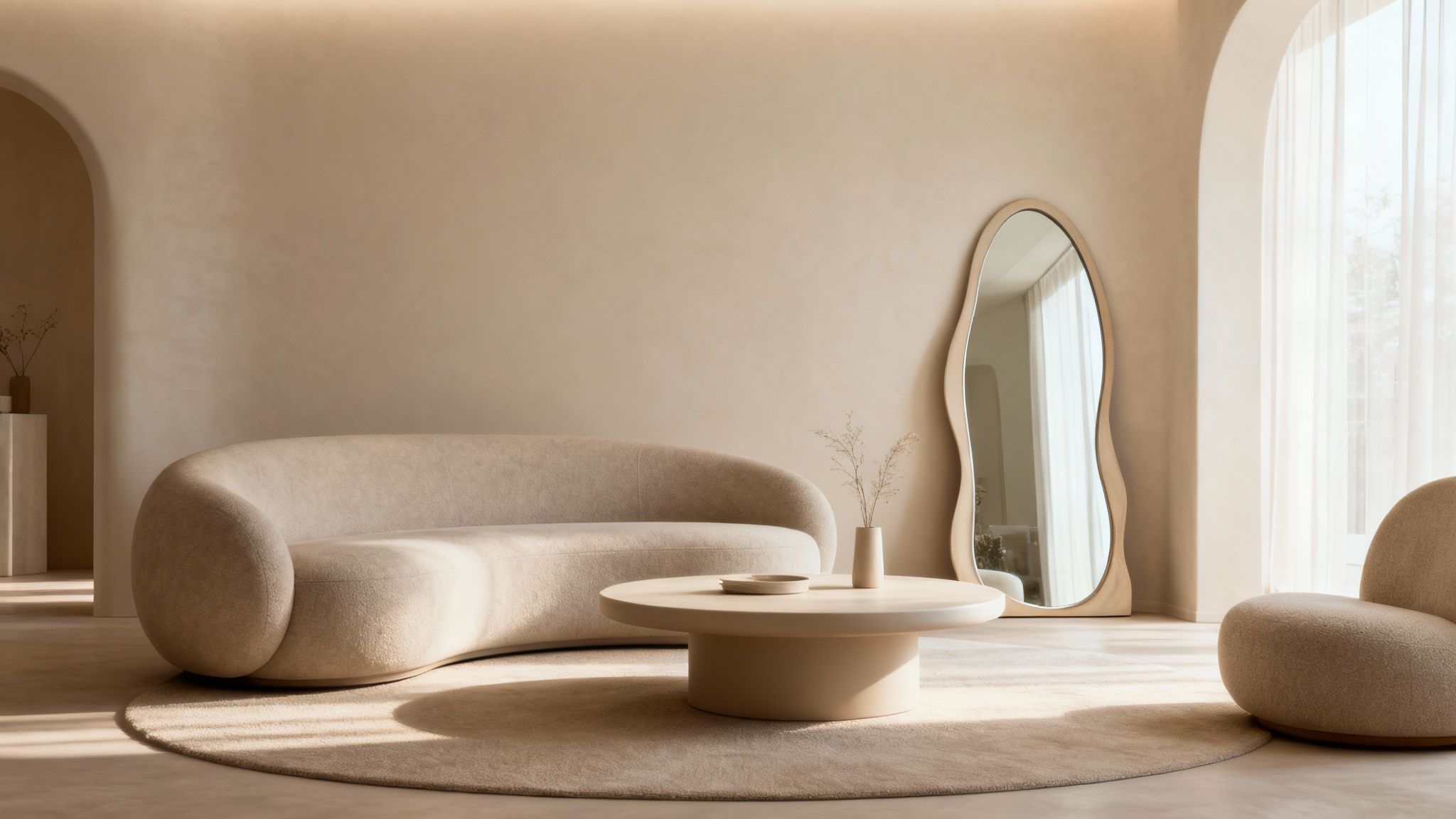
Choosing the Right Statement Piece
Selecting the perfect fixture requires careful consideration of scale, style, and placement to ensure it enhances, rather than overwhelms, your living room.
- Scale Appropriately: A common mistake is choosing a fixture that is too small. In a living room with a standard ceiling height, a chandelier should have a diameter that is roughly the sum of the room's length and width in feet, converted to inches.
- Create a Visual Anchor: Centre a sculptural pendant over a coffee table or a seating arrangement to anchor the space and create a cohesive, deliberate look.
- Consider Style: From the iconic branching chandeliers by Lindsey Adelman to the industrial-chic Beat lights by Tom Dixon, select a style that complements your existing decor while still providing a "wow" factor.
Practical Application and Ambiance
Beyond its aesthetic impact, your statement lighting must be functional. Installing dimmer switches is non-negotiable, as it allows you to control the ambiance, shifting from bright, functional light to a soft, intimate glow. Balance your main dramatic piece with simpler, layered secondary lighting like floor lamps or wall sconces to ensure the room is evenly and beautifully lit. For a deeper dive into illumination strategies, you can discover more about statement lighting ideas for your home.
5. Textural Layering
Textural layering is the art of combining various materials, fabrics, and finishes to create depth, warmth, and visual interest in contemporary living rooms. This technique moves beyond colour and pattern, engaging the sense of touch to build a sophisticated and inviting atmosphere. Popularised by designers like Kelly Hoppen and brands such as Restoration Hardware, layering textures prevents minimalist or neutral spaces from feeling flat or sterile, transforming them into rich, dynamic environments.
Creating a Tactile Environment
A well-layered room feels curated and comfortable. The key is to create contrast and balance between different surfaces for a multi-sensory experience.
- Mix Materials: Combine a variety of textures in your furniture and accessories. Think about pairing a smooth leather sofa with chunky cable-knit throws, velvet cushions, and a reclaimed wood coffee table.
- Balance Rough and Smooth: Juxtapose rough, natural textures like jute or reclaimed wood with sleek, smooth surfaces like glass, polished metal, or silk. This contrast highlights each material's unique quality.
- Layer Vertically: Extend texture to your walls with options like grasscloth wallpaper, wood panelling, or limewash paint to add subtle depth that complements the furnishings.
Practical Tips for Layering
Applying texture effectively requires a thoughtful approach to ensure the result is harmonious rather than chaotic. Start by choosing a primary texture and build upon it with complementary or contrasting elements. A simple rule of thumb is to incorporate at least three distinct textures within your design to achieve a rich, layered feel. For instance, layering rugs by placing a smaller, plush rug over a larger, low-pile one can instantly add dimension. For more ideas, you can learn how to layer rugs effectively to master this designer technique.
6. Smart Home Technology Integration
Contemporary living rooms are increasingly defined by the seamless integration of smart home technology, which enhances convenience and entertainment without sacrificing aesthetic appeal. This approach thoughtfully embeds devices like screens, speakers, and automated controls into the room's design, preventing technology from cluttering the space. Popularised by ecosystems like Apple HomeKit and Google Nest, this creates a home that is both beautiful and intelligent, where technology serves the resident, not the other way around.
Blending Tech with Décor
The key to a successful smart living room is making the technology feel like a natural, almost invisible, part of the environment.
- Disguised Displays: Choose televisions that double as art, such as Samsung's The Frame, which displays high-resolution artwork when not in use, blending directly into a gallery wall.
- Invisible Audio: Install in-wall or in-ceiling speakers, like those from Sonos, for an immersive sound experience that doesn’t require bulky, visible units.
- Integrated Furniture: Opt for furniture with built-in charging ports or smart features to keep surfaces clear and reduce the need for visible cables and power strips.
Practical Implementation
Planning is crucial for a cohesive and functional smart living space. Start by considering how you use the room and which automations would genuinely improve your daily life. Invest in high-quality cable management solutions and cord concealers to keep wires tidy and out of sight. Utilise smart plugs to affordably retrofit existing lamps and appliances, allowing you to control them via voice command or an app. Prioritise creating a unified ecosystem where all devices can communicate, ensuring a smooth and intuitive user experience for your contemporary living room.
7. Bold Accent Walls
Contemporary living rooms often use a bold accent wall to create a dramatic focal point without overwhelming the entire space. This design technique involves treating one wall differently from the others through colour, texture, material, or pattern, adding depth and personality. Modern approaches, popularised by designers like Studio McGee and brands such as Farrow & Ball, go beyond simple paint to include innovative materials and applications.
Creating a Statement
Choosing the right wall and material is crucial for making a stylish impact. The goal is to draw the eye and anchor the room’s design scheme.
- Strategic Placement: Select the wall behind your main seating area or entertainment unit for maximum effect, as it's a natural focal point.
- Material Choice: Explore options beyond paint. A reclaimed wood plank wall adds rustic warmth, exposed brick offers an industrial edge, and a floor-to-ceiling stone fireplace provides a natural, textured centrepiece.
- Colour & Pattern: A deep navy or emerald green paint can create a sophisticated, moody backdrop. For a more luxurious feel, consider a statement wallpaper from a brand like Cole & Son. If you are exploring a rich blue colour scheme, you can find inspiration for a blue and grey living room.
Practical Application Tips
To ensure your accent wall enhances your space rather than overpowering it, maintain a sense of balance. Apply the 60-30-10 rule, where the accent wall represents the 10% bold element in your colour palette, complemented by a dominant colour (60%) and a secondary colour (30%). Always test paint samples in different lighting conditions before committing. Balance a bold wall with neutral furnishings and textiles to create a cohesive and inviting contemporary living room.
8. Low-Profile, Modular Furniture
Low-profile, modular furniture is a defining feature in many contemporary living rooms, championing flexibility and a relaxed, spacious aesthetic. These pieces sit closer to the ground, which visually enhances the perception of ceiling height and opens up the room. Popularised by innovative brands like Lovesac and Burrow, this design approach allows homeowners to reconfigure layouts to suit evolving needs, from hosting guests to creating a cosy family nook.
Maximising Flexibility and Form
The core appeal of modular furniture is its adaptability. To make the most of this style, it’s crucial to balance its unique form with practical functionality.
- Anchor Your Arrangement: Use a large area rug to visually ground the separate modules and prevent them from drifting apart on smooth flooring.
- Ensure Stability: Opt for modular systems that include connecting hardware or clips to lock pieces together, creating a stable and cohesive seating unit.
- Vary the Heights: Mix your low-profile sofa with a taller armchair or floor lamp to add visual interest and break up the horizontal lines, creating a more dynamic look.
Practical Considerations
While stylish, low-profile designs require careful planning to ensure comfort and usability. Before committing, consider the practical side of living with this furniture style. Test the seat height in person, especially if mobility is a concern for any household members or frequent visitors. Also, ensure the cushion density provides adequate support for prolonged sitting. When planning your layout, maintain at least 18 inches of clear walkway space around the configuration to ensure easy movement throughout the room.
9. Mixed Metal Finishes
Contemporary design has moved away from the outdated rule of matching all metal finishes, instead embracing the sophisticated practice of mixing metals. This approach combines different tones and sheens, such as warm brass with cool chrome or aged copper with matte black, to create a layered and dynamic aesthetic. Popularised by design tastemakers like Nate Berkus and Amber Lewis, this technique helps contemporary living rooms feel collected over time rather than styled from a catalogue.
Creating Metallic Harmony
Successfully mixing metals requires a thoughtful approach to avoid a visually cluttered or disjointed look. The goal is to create a cohesive, curated feel.
- Select a Dominant Metal: Choose one primary metal to account for about 60% of the finishes. This is often established by the largest or most prominent pieces, like a statement chandelier or a coffee table frame.
- Choose Accent Metals: Add one or two secondary metals for contrast and depth. Use these sparingly on smaller items like picture frames, cabinet hardware, or decorative objects.
- Repeat for Intentionality: Ensure each metal finish appears at least twice in the room. This repetition makes the choice feel deliberate and integrated rather than random.
Practical Considerations
When combining metals, consider both their finish and placement. Matte black acts as a versatile neutral that pairs well with almost any metallic tone, grounding the space. Distribute your chosen metals throughout the room to achieve a balanced look; for example, if you have a brass floor lamp on one side, place brass-framed art on the opposite wall. Pay attention to undertones: pair warm metals like gold and copper together, and cool metals like chrome and nickel.
10. Curved and Organic Furniture Forms
In a soft rebellion against the sharp, linear forms that have long dominated minimalist design, contemporary living rooms are now embracing curved furniture and organic shapes. This trend favours rounded sofas, oval coffee tables, and sculptural pieces that introduce a sense of flow and softness. Popularised by design icons like Vladimir Kagan and Kelly Wearstler, these forms create more inviting and approachable environments, prioritising human comfort and gentle aesthetics.
Balancing Curves and Angles
The key to successfully incorporating organic shapes is balance, preventing the space from feeling overly soft or lacking structure. A well-considered mix of curves and straight lines creates a dynamic and sophisticated interior.
- Create a Focal Point: Allow a single, significant curved piece, like a serpentine sofa, to be the star of the room. Surround it with more angular elements, such as a rectangular rug or a linear media unit, for striking contrast.
- Mix and Match: If a large curved sofa feels too bold, pair an angular sofa with a rounded coffee table or a pair of sculptural, curved armchairs. This creates a harmonious dialogue between different forms.
- Echo the Shape: Reinforce the theme by incorporating other rounded elements. An arched floor mirror, a circular side table, or a pendant light with a domed shade can echo the curves of your main furniture pieces.
Practical Placement and Styling
The placement of curved furniture can dramatically alter the feel and function of a room. Unlike traditional sofas that sit flush against a wall, curved pieces offer more versatile arrangement possibilities. Placing a curved sofa in the centre of a large room turns it into a sculptural statement that can be admired from all angles. This positioning also helps to naturally define a conversational zone in an open-plan layout, encouraging social interaction and creating an intimate, cocooning atmosphere.
Contemporary Living Room Design Elements Comparison
Crafting Your Contemporary Sanctuary
As we've journeyed through the dynamic and inspiring world of contemporary living rooms, a clear picture emerges. The modern sanctuary is no longer about adhering to a single, rigid design doctrine. Instead, it’s a fluid, deeply personal canvas that celebrates individuality, functionality, and sophisticated comfort. From the airy expanse of open-concept layouts to the mindful simplicity of minimalism, the principles we've explored are building blocks, not unbreakable rules. The most successful designs artfully blend these elements to create a space that is both visually stunning and perfectly attuned to the rhythms of daily life.
The core takeaway is this: contemporary design is an ongoing dialogue between form, function, and personal expression. It’s about creating a space that works for you. Whether you were drawn to the organic warmth of biophilic design and curved furniture forms, or the sleek, high-tech allure of smart home integration and mixed metal finishes, the power lies in the combination. A bold accent wall can provide the perfect backdrop for low-profile modular seating, just as intricate textural layering can soften the clean lines of minimalist architecture.
Your Path to a Contemporary Living Room
Feeling inspired to transform your space? The key is to start with a focused approach rather than attempting a complete overhaul at once. Consider these actionable next steps to begin your design journey:
- Identify Your Core Concepts: Revisit the ideas in this article. Which two or three resonated most strongly with you? Perhaps it's the idea of making statement lighting a central feature, or the appeal of flexible, modular furniture. Choose your priorities to create a clear vision.
- Create a Mood Board: Collect images, fabric swatches, and colour samples. This visual guide will help you maintain a cohesive aesthetic as you select furniture and décor, ensuring your mixed metals and layered textures feel harmonious.
- Start Small, Think Big: You don't need a massive budget to make a significant impact. Introducing a single element, like a dramatic floor lamp or a bold, abstract rug, can instantly elevate the room and set the tone for future updates.
Ultimately, mastering the art of the contemporary living room is about more than just following trends. It's about cultivating a space that supports your lifestyle, inspires creativity, and provides a true sense of sanctuary. By thoughtfully selecting and combining these design principles, you can craft a living room that is not only stylish and current but also a genuine reflection of who you are. Your home should be your haven, and with these tools, you are well-equipped to make that vision a beautiful reality.

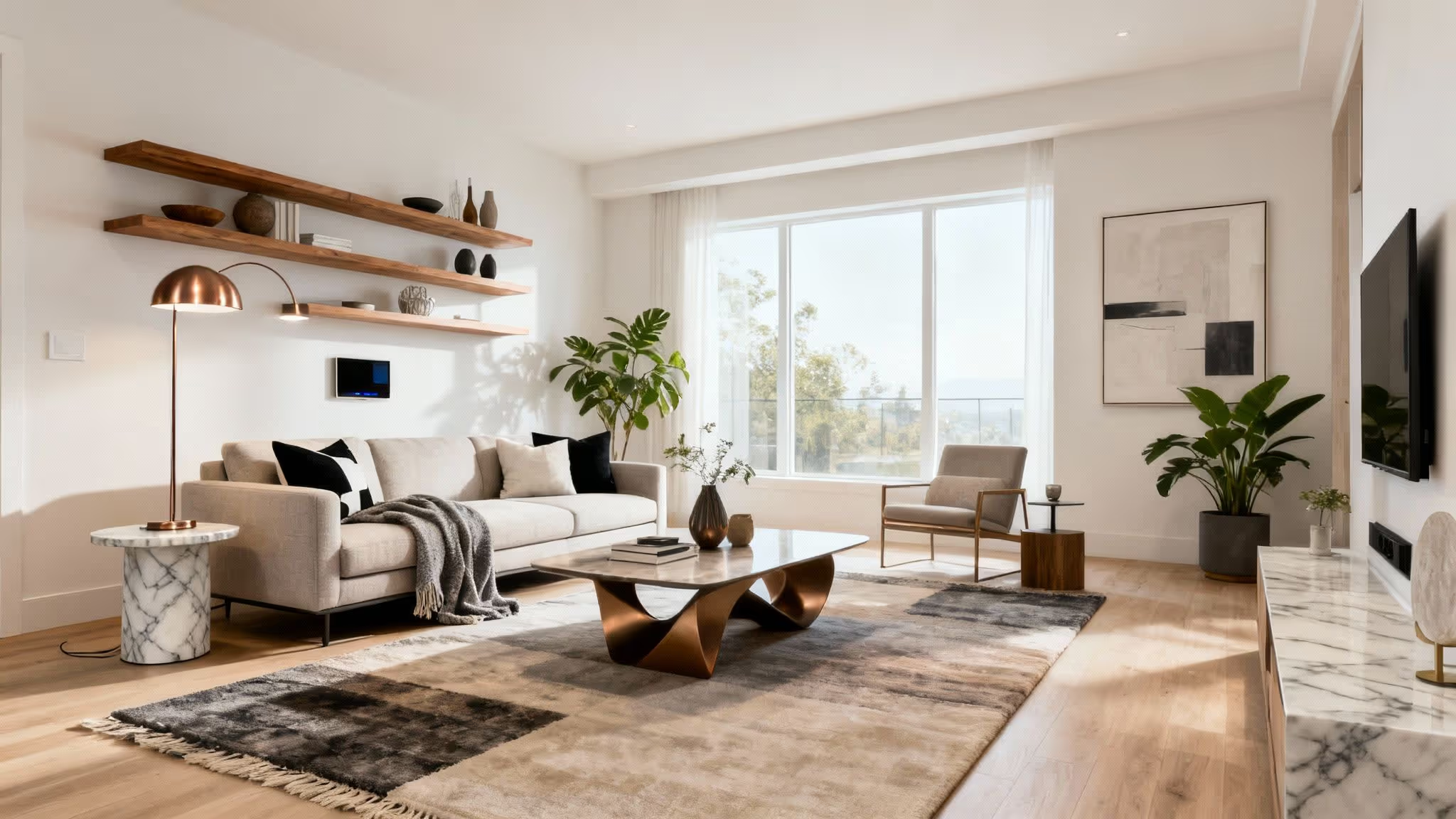

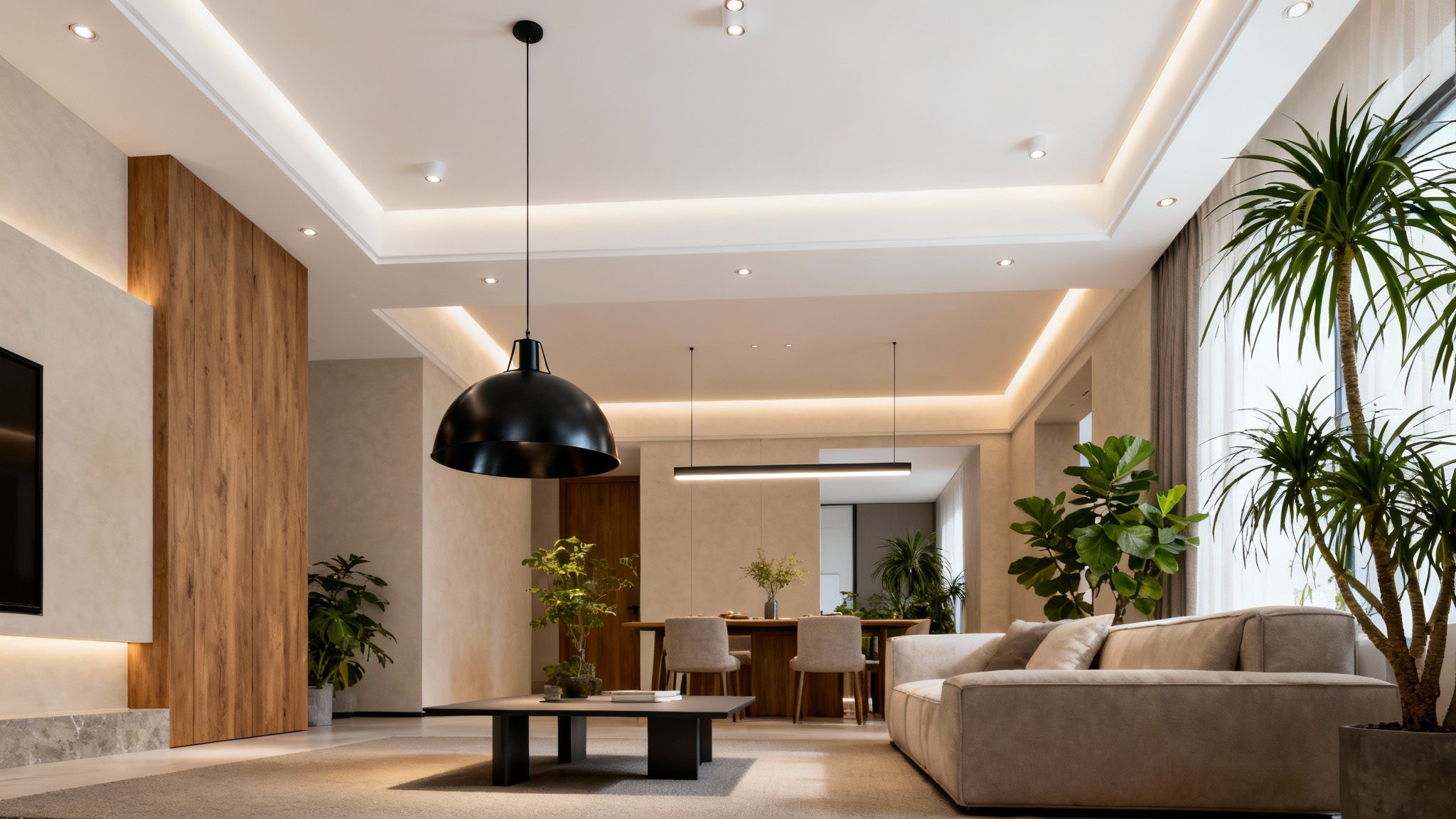
.jpeg)